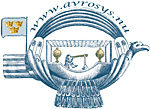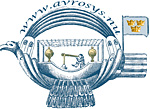|
|
www.avrosys.nu -
Copyright-free
Scandinavian Archive Prints |
|
|
|
||
|
|
||
|
|
||
|
|
||
|
Lake Mjøsa - View from the Shore at Vardal
- the Ruins of the Cathedral of Hamar. Artist: B. Hansen. Woodcut from 1882. The beautiful Mjøsa is Norway's largest lake. From its southernmost point at Minnesund in Eidsvoll to its northernmost point in Lillehammer it is 117 km long. It is 15 km wide near Hamar. Dams built in Vorma have raised the water level by almost four meters. The towns of Hamar, Gjøvik and Lillehammer were founded along the shores of the lake. Before the construction of railways along the lake, it was an important transport route. Today, aside from minor leisure boating and the beautiful old paddle steamer Skibladner from 1856, there is no water traffic on the lake. The main train line, Dovrebanen, between Oslo and Trondheim goes along the eastern shore, making stops in Hamar and Lillehammer. The largest and only island in Mjøsa is Helgøya. Except for Helgøya, Mjøsa only contains small islets. The most interesting of these are Steinsholmen, with the ruins of a Middle Age citadel. Hamar is a town and municipality in Hedmark Fylke (County). It is a part of the traditional region of Hedmarken. Between the year 500 and 1000 AD, Aker farm was one of the most important power centres in Norway, located just a few kilometres away from today's Hamar. Around 1100 A.D. the centre was moved from Aker to the peninsula near Rosenlundvika, today known as Domkirkeodden (“the Cathedral Cape”). Much of the information about medieval Hamar is derived from the Hamar Chronicles, dated to about 1550. The town is said to have reached its glory days in the early 1300’s, dominated by the cathedral, the bishop’s manor, the fortress and surrounding urbanization. The town was known for its fragrant apple orchards, but there were also merchants, craftsmen, and fishermen in the town. After the Christianization of Norway in 1030, Hamar began to gain influence as a centre for trade and religion. The first bishop of Hamar was Arnold (1124-1152). He began to build the now ruined cathedral of Christ Church, which was completed by Bishop Paul (1232-1252). Hamar remained an important religious and political centre in Norway, organized around the cathedral and the bishop's manor until the Reformation in 1536, when it lost its status as a diocesan centre after the last Catholic bishop was taken prisoner and sent to Denmark. Hamar, like most of Norway, was severely diminished by the Black Plague in 1349, and by all accounts continued this decline until the Reformation, after which it disappeared. The Reformation in Norway took less than 10 years to complete, from 1526 to 1536. The fortress was made into the residence of the sheriff and renamed Hamarhus fortress. The cathedral was still in use but fell into ruins culminating with the Swedish army’s siege and attempted demolition in 1567 during the Northern Seven Years' War, when the manor was also devastated. By 1587, merchants in Oslo had succeeded in moving all of Hamar’s business activities to Oslo. Though some regional and seasonal trade persisted into the 1600’s, Hamar ceased to exist as town. Instead, the area was used for agriculture under the farm of Storhamar, though the ruins of the cathedral, fortress, and lesser buildings became landmarks for centuries since then. As early as 1755, the Danish government in Copenhagen expressed an interest in establishing a trading centre at Mjøsa. Elverum was considered a frontier town with frequent unrest, and there was even talk of encouraging the dissenting Hans Nielsen Hauge to settle in the area. In 1812, negotiations started in earnest, when the regional governor of Kristians Amt, proposed establishing a market at Mjøsa. A commission was set up in 1814, with the mandate of determining a suitable site for a new town along the shore. On 8 June 1815, the commission recommended establishing it at Lillehammer. The parliament finally decided on Lillehammer, relegating Hamar once more, it seemed, to be a sleepy agricultural area. As steamboats were introduced on the lake, the urban elite developed an interest in the medieval Hamar, and in 1841, editorials appeared advocating the reestablishment of a town at Storhamar. By then the limitations of Lillehammer’s location had also become apparent, in particular those of its shallow harbour. On 26 April 1848, the king signed into law the establishment of Hamar on the grounds of the farms of Storhamar and Holset, along the shores of Mjøsa. The building activety started in the spring of 1849. The first buildings were much like sheds, but there was great enthusiasm, and by the end of 1849, ten buildings were insured in the new town. By the end of 1860 there were 100 insured houses in the town. The shore side properties were obliged to grow gardens, setting the stage for a green urban landscape. The first passenger terminal in Hamar was in fact a crag in the lake, from which travellers were rowed into the town. In 1850, another pier was built with a two-storey terminal building. All this was complicated by the significant seasonal variations in water levels. In 1857 a canal was built around a basin that would allow freight ships to access a large warehouse. Although the canal and basin still weren’t deep enough to accommodate passenger steamships, the area became one of the busiest areas in the town and the point around which the harbour was further developed. The Diocese of Hamar was established in 1864, and the Hamar Cathedral was consecrated in 1866 and remains a central point in the city. In Hamar’s early days, the entire population consisted of young entrepreneurs, and little was needed in the way of social services. After a few years, a small number of indigent people needed support, and a poorhouse was erected. The Hedmark Museum, located on Domkirkeodden, is an important historical landmark in Hamar, an outdoor museum with remains of the medieval chatedral built-in under protective glass housing, the Episcopal fortress and a collection of old farm houses. Hamar is also known for its indoor long track speed skating arena, the Olympia Hall, better known as Vikingskipet ("The Viking ship") for its shape. It was built to host the speed skating competitions of the 1994 Winter Olympics that were held in nearby Lillehammer. There is also the Hamar Olympic Amphitheatre which hosted the figure skating and short track speed skating during the Winter Olympics. Hamar is an important railway junction between two different lines to Trondheim. Rørosbanen, the old railway line, branches off from the mainline Dovrebanen. The Norwegian National Railway Museum (Norsk Jernbanemuseum) is situated in Hamar. Below: S/S Skibladner at Mjøsa in July 2006. The ship was delivered in 1856 from Motala Verkstad in Sweden. Photo from Wikimedia Commons. |
|
|
 |
||
Order a scanning of the woodcut in large size (14864 x 10699 pixels) The woodcut, scanned in the very large size mentioned above is sold as a JPG-file for € 10 or $ 10. Mail me at henriksson@avrosys.nu. Ref. no 100780. |
||
| © 2009 Lars Henriksson. Updated: 2009-05-25. | ||
|
Custom Search
|
||


